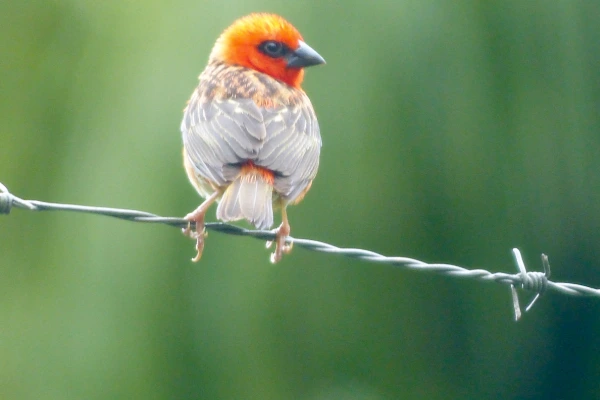Lightfoot Travel
WhatsApp Business Account

Life on Mauritius is like living in a giant kaleidoscope. The island is an intoxicating melee of vibrant colours. Every time I step out of my door, I find inspiration. From the tropical birds high in the fruit trees or the ghost crabs peeking out of their burrows on the beach, there is always a fascinating encounter awaiting.
But what makes this place even more special, is that there are species here that don’t exist anywhere else. When I volunteered for a local nature conservation NGO, I learned about the importance of endemic species and the importance of preserving the island’s fragile ecosystem.

This was a pivotal step for me in my photography journey as it gave me the chance to improve my approach and communicate a more meaningful message. Not only was I witnessing nature’s amazing evolution, but my photographs would become a tool that would bridge the gap between experts and the public.
In Mauritius, we have only two seasons – it’s 27°C in the summer, which runs from October to March and around 18°C in the winter months that run from April to September. Natural light lasts from 6am to 6pm. However, as an outdoor photographer I always rise early so that I can shoot at sunrise. Heat, humidity, wind and rain can be a challenge, but I’ve learnt to cultivate plenty of patience. You can often see me waiting for hours in specific spots just to capture that perfect shot.

I feel lucky to live in a small village on the northern coast called Goodlands. The name itself gives a hint of how green and fertile the surroundings are. This place is perfect for a nature lover like me. In less than 15 minutes, I can drive to the nearest beach to go crab spotting among the sunny sand and azure water.
Nature is the ultimate teacher. It encourages you to train your eye and discover delicate patterns and intricate details. From the soft yellow petals of the hibiscus flower, to the dashing red plumage of the fody bird or the vibrant green veins of the elephant ear leaf – you have the ultimate photography muses around you.


Mauritius most famous inhabitant – the dodo – may be extinct, but as a photographer it is important to show what else is living in the jungle so that they don’t go the same way as this unfortunate creature. From flying foxes and geckos, to the pink pigeon and giant tortoises… We may not have big game in this part of Africa, but our animals are just as captivating. It has encouraged me to develop another skill that I have become very fond of – macro close-up photography.
It has given me many unexpected encounters. I have become fascinated by the smallest creatures in the jungle. The busy yellow wasps that spend the summer months building their nests under leaves and in corners intrigue me. While they are primed to sting at any time, it has not stopped me from getting closer.
I have also become passionate about reptiles. One of my most favourite photography subjects is the day gecko. It seems to accept my presence and is a faithful model. It is one of the cutest little lizards you can imagine. A colourful and cheeky creature looking at you while swiftly preparing its next move.
Though living in Mauritius you don’t have to travel far to capture the perfect shot. My garden is often the location of some of my best shots. I have encouraged the wildlife to come closer to my home. I grow banana trees as I know that geckos and chameleons love to use it leaves to hide from the sun. I also grow wildflowers in the garden as they attract all sorts of insects such as butterflies and grasshoppers.
One of my most meaningful experiences as a nature photographer in Mauritius was when I joined a team of French naturalists and filmmakers for an intense week of shooting. We explored the island of Mauritius from south to north, filming key species and meeting nature experts. Our team captured numerous breathtaking moments, including diving with 19 eagle rays on the west coast and walking with giant tortoises in an endemic forest. One day in particular still stands out in my mind. We flew into a private nature reserve by helicopter and woke to find hundreds of red-tailed tropical birds flying all around us.
Even though I have travelled around the island for many years, I am always eager to pack my camera for new adventures. It’s not hard to see why this island is called 'Stella Clavisque Maris Indici' – 'The star and key of the Indian Ocean'.

This tropical island offers visitors a quintissential beach break and makes a nice alternative to the Maldives.
The One&Only Le Saint Geran is set to reopen its doors in October 2024 following an extensive refurbishment. The Grand Dame of the island is a sophisticated and elegant choice for both couples and families.
Looking for a little privacy? Walk down a lantern-lit pontoon through mangrove trees until you find yourself at Le Barachois at Constance Prince Maurice. Dine on one of the restaurants 5 floating decks.
Mauritius isn’t short of attractions. On shore you can join a quad biking trip through the Domaine de L’Etoile, a picturesque national park where deer roam among ebony and cinnamon trees. Offshore, you can charter a catamaran, go snorkelling in the Indian Ocean and enjoy a barbecue lunch cooked up by your own chef.
MauritiusOkavango DeltaBotswanaAfrica
Relax on Mauritius’ idyllic beaches
Go snorkelling or water skiing in beautiful turquoise waters
Explore the Okavango Delta, teeming with wildlife viewing opportunities
Take in the landscape and see a multitude of birds and elephants from a boat
Embark on a gentle nature walk with your guide
